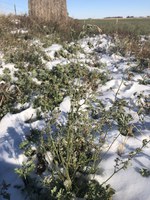Killing Freeze Affects Alfalfa, Sorghum/Sudangrass Grazing
(Click the image below to view a high-resolution image that can be downloaded)
A killing freeze already has occurred in parts of North Dakota, prompting livestock producers to wonder when their cattle can graze alfalfa, sorghum-sudangrass and sudangrass safely.
Livestock producers are concerned about bloat. It occurs when gases created by fermentation cause the rumen reticulum (part of the cow’s stomach) to inflate or overstretch.
Alfalfa
“In reality, the few days immediately after a frost, the bloat potential in alfalfa goes much higher,” says Carl Dahlen, an associate professor in North Dakota State University’s Animal Sciences Department.
“The frost ruptures some of the cell walls in the leaves, increasing the potential for bloat due to an accentuated number of small particles and availability of rapidly fermentable material,” he explains. “The frost already has started the breakdown process, and the animal bloats more readily.”
A killing freeze ruptures all of the cell walls, creating the potential for bloat to be highest directly following the killing freeze.
“Once the above-ground portion of the alfalfa plant has totally died back, it is safe to graze,” Dahlen says. “We generally recommend not grazing for seven to 10 days after the killing freeze.”
Sorghum/sudangrass and Sudangrass
Sorghum, sorghum/sudangrass and sudangrass are annual warm-season forage crops planted for silage, haylage or hay, or they can be planted in cover crop mixtures. These grasses contain cyanide, which can be toxic to livestock.
“These plants produce cyanogenic glycosides during their growing stage,” says Kevin Sedivec, NDSU Extension rangeland management specialist. “Glycosides are compounds that break down into glucose sugars by hydrolysis, or addition of water. This decomposition process frees the cyanide from its chemical bond, and it becomes toxic hydrocyanic acid, frequently called prussic acid.”
The intact, still-bonded cyanide and glycosides are not poisonous, but when certain enzymes are present, they are highly toxic to animals. The enzymes involved in the hydrolysis usually are in the same plant, but they may be available from other sources. An animal’s digestive juices may cause the hydrolysis to occur.
This intact glycoside occurs in these plants under normal growing conditions. When livestock eat plants that contain such glycosides, are more than 18 to 24 inches tall and are not under water stress, the animals readily eliminate the glycosides before enough concentration occurs to be harmful.
However, certain conditions such as frost and a killing freeze may increase cyanogenic glycosides in the plants, Sedivec cautions. Wilting and frost injury may cause a rapid increase of prussic acid in a plant that would otherwise have been nontoxic.
Prussic acid is released very quickly from the glycoside form in frozen leaves, so frosted leaves are very dangerous to eat until they begin to dry out. Typically, once the leaves are totally brown or dead, usually seven days after a killing frost, the aboveground portion of these forage plants is safe to graze.
“Because alfalfa is a perennial plant, it is important to not graze your alfalfa or alfalfa-grass stands short,” Sedivec says. “If you do, your risk for winterkill increases, especially in stands greater than 4 years old. We recommend you leave a minimum stubble height of 4 to 6 inches to assure proper snow catch and protection of the alfalfa crown or growth point.”
NDSU Agriculture Communication - Oct. 12, 2018
| Source: | Kevin Sedivec, 701-424-3606, kevin.sedivec@ndsu.edu |
|---|---|
| Source: | Carl Dahlen, 701-231-5588, carl.dahlen@ndsu.edu |
| Editor: | Ellen Crawford, 701-231-5391, ellen.crawford@ndsu.edu |


